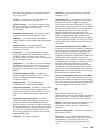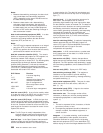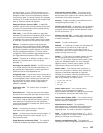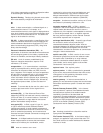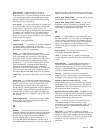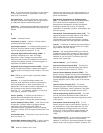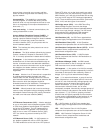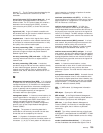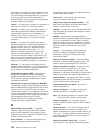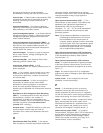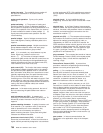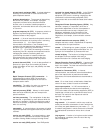protocol does not provide error recovery and flow
control and does not guarantee the reliability of the
physical network.
interoperability. The capability to communicate,
execute programs, or transfer data among various
functional units in a way that requires the user to have
little or no knowledge of the unique characteristics of
those units. (T)
intra-area routing. In Internet communications, the
routing of data within an area.
Inverse Address Resolution Protocol (InARP). In
the Internet suite of protocols, the protocol used for
locating a protocol address through the known hardware
address. In a frame-relay context, the data link
connection identifier (DLCI) is synonymous with the
known hardware address.
IPPN. The interface that other protocols can use to
transport data over IP.
IP address. The 32-bit address defined by the Internet
Protocol, standard 5, Request for Comments (RFC)
791. It is usually represented in dotted decimal notation.
IP datagram. In the Internet suite of protocols, the
fundamental unit of information transmitted through an
internet. It contains source and destination addresses,
user data, and control information such as the length of
the datagram, the header checksum, and flags
indicating whether the datagram can be or has been
fragmented.
IP router. A device in an IP internet that is responsible
for making decisions about the paths over which
network traffic will flow. Routing protocols are used to
gain information about the network and to determine the
best route over which the datagram should be
forwarded toward the final destination. The datagrams
are routed based on IP destination addresses.
IPXWAN. A Novell protocol that is used to exchange
router-to-router information before exchanging standard
Internetwork Packet Exchange (IPX) routing information
and traffic over wide area networks (WANs).
L
L2TP Access Concentrator (LAC). A device attached
to one or more public service telephone network (PSTN)
or ISDN lines capable of handling both PPP operation
and of the L2TP protocol. The LAC implements the
media over which L2TP operates. L2TP passes the
traffic to one or more L2TP Network Servers (LNS).
L2TP can tunnel any protocol carried by the PPP
network.
L2TP Network Server (LNS). An LNS operates on
any platform capable that can be a PPP end station.
The LNS handles the server side of the L2TP protocol.
Since L2TP relies only on the single media over which
L2TP tunnels arrive, the LNS has only a single LAN or
WAN interface, yet is still able to terminate calls arriving
from any the full range of PPP interfaces supported by
a LAC. These include asynchronous ISDN, synchronous
ISDN, V.120, and other types of connections.
LAN bridge server (LBS). In the IBM Token-Ring
Network Bridge Program, the server that keeps
statistical information about frames forwarded between
two or more rings (through a bridge). The LBS sends
these statistics to the appropriate LAN managers
through the LAN reporting mechanism (LRM).
LAN Emulation (LE). An ATM Forum standard that
supports legacy LAN applications over ATM networks.
LAN Emulation Client (LEC). A LAN Emulation
component that represents users of the Emulated LAN.
LAN Emulation Configuration Server (LECS). A LAN
Emulation Service component that centralizes and
disseminates configuration data.
LAN Emulation Server (LES). A LAN Emulation
Service component that resolves LAN Destinations to
ATM Addresses.
LAN Network Manager (LNM). An IBM licensed
program that enables a user to manage and monitor
LAN resources from a central workstation.
LAN segment. (1) Any portion of a LAN (for example,
a bus or ring) that can operate independently, but that is
connected to other parts of the network by means of
bridges. (2) A ring or bus network without bridges.
layer. (1) In network architecture, a group of services
that is complete from a conceptual point of view, that is
one out of a set of hierarchically arranged groups, and
that extends across all systems that conform to the
network architecture. (T) (2) In the Open Systems
Interconnection reference model, one of seven
conceptually complete, hierarchically arranged groups of
services, functions, and protocols, that extend across all
open systems. (T) (3) In SNA, a grouping of related
functions that are logically separate from the functions
in other groups. Implementation of the functions in one
layer can be changed without affecting functions in
other layers.
LE. LAN Emulation. An ATM Forum standard that
supports legacy LAN applications over ATM networks.
LEC. LAN Emulation Client. A LAN Emulation
component that represents users of the Emulated LAN.
LECS. LAN Emulation Configuration Server. A LAN
Emulation Service component that centralizes and
disseminates configuration data.
Glossary 701





